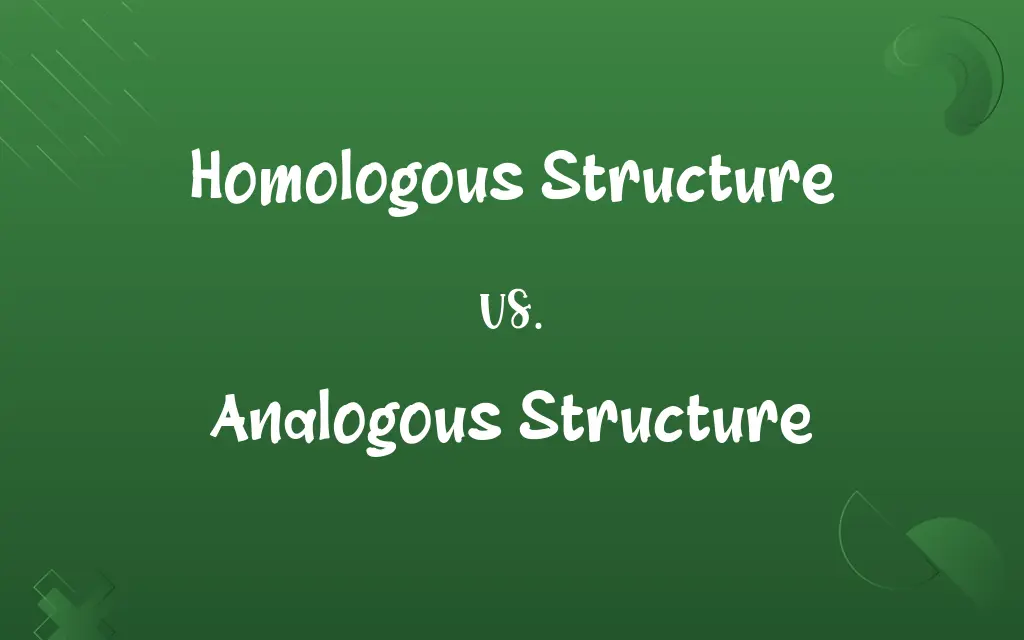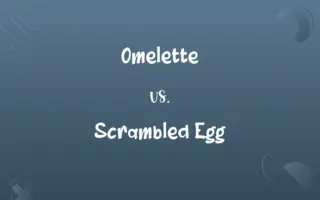Homologous Structure vs. Analogous Structure: Know the Difference

By Shumaila Saeed || Published on December 28, 2023
Homologous structures are anatomical resemblances that represent evolution from a common ancestor; analogous structures perform similar functions but evolve separately in different species.

Key Differences
Homologous structures in different species point to a common ancestor, suggesting evolutionary relationships. Analogous structures, while serving similar functions, evolve independently in species without a common ancestor, highlighting convergent evolution.
Shumaila Saeed
Dec 28, 2023
The similarity in homologous structures arises from shared ancestry, not necessarily shared function, as seen in the forelimbs of mammals. In contrast, analogous structures like the wings of birds and insects evolve separately to serve similar purposes but do not indicate a close evolutionary relationship.
Shumaila Saeed
Dec 28, 2023
Homologous structures may not perform the same function but share an underlying anatomy, such as the wing of a bat and the flipper of a dolphin. Analogous structures, like the fins of fish and flippers of penguins, though similar in function, arise from different anatomical origins and evolutionary paths.
Shumaila Saeed
Dec 28, 2023
Studying homologous structures helps scientists understand evolutionary paths and shared traits among species. On the other hand, analogous structures are key to understanding how different species adapt similarly to comparable environmental challenges despite their diverse evolutionary histories.
Shumaila Saeed
Dec 28, 2023
An example of homologous structures is the skeletal structure of vertebrate limbs, which varies in function but shares a common structural blueprint. Conversely, analogous structures like the streamlined bodies of sharks and dolphins illustrate how different species can evolve similar features independently for efficient swimming.
Shumaila Saeed
Dec 28, 2023
ADVERTISEMENT
Comparison Chart
Evolutionary Significance
Indicates evolutionary relationships
Shows convergent evolution
Shumaila Saeed
Dec 28, 2023
Structural Similarity
Similar in structure, different in function
Different in structure, similar in function
Shumaila Saeed
Dec 28, 2023
ADVERTISEMENT
Homologous Structure and Analogous Structure Definitions
Homologous Structure
Homologous structures may vary in function but have similar embryonic origin.
The homologous structures of bird and reptile limbs indicate their evolutionary connection.
Shumaila Saeed
Dec 13, 2023
Analogous Structure
Analogous structures show how different species can develop similar features independently.
The wings of birds and butterflies are analogous structures, showcasing convergent evolution.
Shumaila Saeed
Dec 13, 2023
Homologous Structure
Homologous structures can be identified by their similar morphology and anatomy.
Scientists study homologous structures like vertebrate skeletons to trace evolutionary paths.
Shumaila Saeed
Dec 13, 2023
Analogous Structure
Analogous structures are similar features in different species due to convergent evolution.
The wings of bats and insects are analogous structures, evolved independently for flight.
Shumaila Saeed
Dec 13, 2023
Homologous Structure
Homologous structures are physical features shared by species due to common ancestry.
The bones in a whale's flipper are homologous structures to the human hand.
Shumaila Saeed
Dec 13, 2023
ADVERTISEMENT
Analogous Structure
Analogous structures serve similar functions but do not indicate common ancestry.
The fins of sharks and dolphins are analogous structures, evolved for swimming efficiency.
Shumaila Saeed
Dec 13, 2023
Homologous Structure
Homologous structures are evidence of divergent evolution from a similar ancestral blueprint.
The varied limbs of mammals are homologous structures, evolved for different purposes.
Shumaila Saeed
Dec 13, 2023
Analogous Structure
Analogous structures are examples of similar adaptations in unrelated organisms.
The analogous structures of cactus spines and pine needles evolved for water conservation.
Shumaila Saeed
Dec 13, 2023
Homologous Structure
Homologous structures demonstrate how different species can evolve from a common ancestor.
The homologous bone structures in vertebrate limbs show their shared evolutionary history.
Shumaila Saeed
Dec 13, 2023
Analogous Structure
Analogous structures arise when different species adapt to similar environmental challenges.
The streamlined bodies of sharks and penguins are analogous structures for fast swimming.
Shumaila Saeed
Dec 13, 2023
Repeatedly Asked Queries
What is an analogous structure?
An analogous structure is a similar feature in different species, evolved independently.
Shumaila Saeed
Dec 28, 2023
What causes the development of analogous structures?
Analogous structures develop due to convergent evolution in response to similar environmental challenges.
Shumaila Saeed
Dec 28, 2023
What defines a homologous structure?
A homologous structure is a feature shared by different species due to common ancestry.
Shumaila Saeed
Dec 28, 2023
How do homologous structures arise?
Homologous structures arise from divergent evolution from a common ancestral form.
Shumaila Saeed
Dec 28, 2023
Do analogous structures indicate a close evolutionary relationship?
No, analogous structures do not imply a close evolutionary relationship between species.
Shumaila Saeed
Dec 28, 2023
Are analogous structures found in closely related species?
No, analogous structures are typically found in species that are not closely related.
Shumaila Saeed
Dec 28, 2023
Can homologous structures have different functions?
Yes, homologous structures can vary in function but share a common structural origin.
Shumaila Saeed
Dec 28, 2023
How do homologous structures support the theory of evolution?
Homologous structures support evolution by demonstrating changes from a common ancestor over time.
Shumaila Saeed
Dec 28, 2023
Are analogous structures a result of genetic similarities?
No, analogous structures arise from similar environmental pressures, not genetic similarities.
Shumaila Saeed
Dec 28, 2023
What is an example of a homologous structure?
The forelimbs of humans and wings of bats are examples of homologous structures.
Shumaila Saeed
Dec 28, 2023
Can you give an example of an analogous structure?
The wings of birds and insects are examples of analogous structures.
Shumaila Saeed
Dec 28, 2023
Why are homologous structures important in biology?
Homologous structures help biologists understand evolutionary relationships and common ancestry.
Shumaila Saeed
Dec 28, 2023
Do analogous structures have similar embryonic origins?
No, analogous structures usually do not have similar embryonic origins.
Shumaila Saeed
Dec 28, 2023
What role do analogous structures play in evolution?
Analogous structures illustrate how different species adapt similarly to comparable environments.
Shumaila Saeed
Dec 28, 2023
Can homologous structures look different?
Yes, despite their common origin, homologous structures can look quite different.
Shumaila Saeed
Dec 28, 2023
Are all similar structures in animals homologous?
No, not all similar structures are homologous; some are analogous due to convergent evolution.
Shumaila Saeed
Dec 28, 2023
How does embryology relate to homologous structures?
Embryology shows that homologous structures develop from similar embryonic tissues, indicating common ancestry.
Shumaila Saeed
Dec 28, 2023
What is an example of homologous structures in plants?
Leaves and stems in different plant species are examples of homologous structures.
Shumaila Saeed
Dec 28, 2023
Can analogous structures be found in plants?
Yes, analogous structures like succulent leaves in unrelated desert plants can occur.
Shumaila Saeed
Dec 28, 2023
Do homologous structures always perform the same function?
No, homologous structures can perform different functions in different species.
Shumaila Saeed
Dec 28, 2023
Share this page
Link for your blog / website
HTML
Link to share via messenger
About Author
Written by
Shumaila SaeedShumaila Saeed, an expert content creator with 6 years of experience, specializes in distilling complex topics into easily digestible comparisons, shining a light on the nuances that both inform and educate readers with clarity and accuracy.









































































